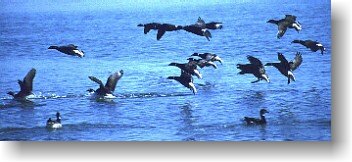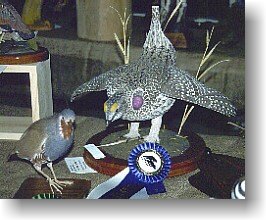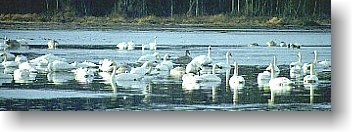
B.C. OUTDOOR ODYSSEY
Endangered Wildlife Species and B.C. Community Wildlife Festivals
with Barry M. Thornton
During the past decade many British Columbia communities have organized festivals in recognition of special wildlife species. Wildlife are an important focus for these regions and it is interesting to note that
in some cases the wildlife species chosen is an endangered species.
 The community of Squamish holds an annual Bald eagle festival during January, recognizing the large number of these birds that concentrate in this coastal valley to feed on salmon. The Bald eagle is one
bird that has just recently returned from a rare and endangered classification.
The Comox Valley has organized a swan festival during early February to highlight the return of the Trumpeter swan. It too was once classified as a rare and endangered waterfowl species.
Other B.C. communities also have festivals for wildlife during peak migrating concentrations. On Vancouver Island, the city of Parksville has organized a Brant festive in April to coincide with the passage of this
small sea goose in the Strait of Georgia as they migrate north to Arctic nesting grounds. This festival now boasts an important west coast juried wildlife carving competition. In November, a Snow Goose Festival is held in
Delta, a direct result of the importance of the nearby Reifel Bird Sanctuary where vast flocks of these birds stage during migrating. During March, the communities of Tofino and Ucluelet hold the Pacific Rim Whale
Festival in Tofino a recognition of these mighty cetaceans as they annually cruise the region.

Endangered species are determined by a committee of the Canadian Wildlife Advisory Council called the Committee on the Status of Endangered Wildlife in Canada (COSEWIC). This committee is responsible for producing the official Canadian list of endangered wildlife or wildlife at risk. Each province and territory also has complimentary lists. COSEWIC annually reviews scientific status reports on species suspected of being in danger and may assign wildlife species to one of the following five categories:
EXTINCT species are species that were formally indigenous to Canada that no longer exist anywhere. Example: Passenger Pigeon.
EXTIRPATED species no longer exist in the wild in Canada, but they occur elsewhere. Example: Greater Prairie-Chicken
ENDANGERED species are threatened with imminent extinction or extirpation throughout all or a significant portion of their Canadian range. Example: Peregrine Falcon.
THREATENED species are likely to become endangered in Canada if the factors affecting their vulnerability are not reversed. Example: Humpback whale.
VULNERABLE species are particularly at risk because of low or declining numbers, small range, or for some other reason, but are not threatened. Example: Grizzly

British Columbia has two complimentary lists of threatened wildlife species. The first, the "RED LIST" shows those wildlife species which "... are candidates for legal designation as endangered or threatened." The
second list, the "BLUE LIST" shows those species which "... are considered to be vulnerable or sensitive."
Some of the species more commonly known on the B.C. RED LIST include; Pacific Giant Salamander, Northern Goshawk, Sage Grouse, Spotted Owl, Vancouver Island Marmot, Sea Otter and Dall's Sheep. The RED LIST totals 64 separate species.
The BLUE LIST totals 87 separate species. Some of those more commonly known include the Western Rattlesnake, Great Blue Heron, Trumpeter Swan, Bald Eagle, Barn Owl, Steller's Jay (British Columbia's official
bird), Wolverine, Grizzly Bear and Vancouver Island's Roosevelt Elk.
The Comox Valley Trumpeter Swan Festival highlights the communities adoption of this magnificent bird. Trumpeter Swans, once shown in that frightening red list, have made tremendous recovery in the past two
decades. They are the largest waterfowl found in North America with an average weight of 11-13 kilos. Like the Canada goose they mate for life when they are three years or older. British Columbia's warm Pacific coast
is the northern extreme of the Pacific waterfowl flyway. As such, and depending upon each winter's weather, the coastal valleys, lakes, and marshes provide wintering locations for almost 14,000 birds. These locations are scattered throughout the Northwest states and southwestern B.C. The Comox Valley on Vancouver Island has the greatest concentration and winters about 1500 birds.

Fortunately, like the Canada goose, the Trumpeter Swan has adapted well to a rural and urban mix of wintering habitat, so much so, that when it increased it's population above 10,000, it was moved from the 'endangered' wildlife category to the 'threatened' category. In the late 1980's, with an even greater increase, it was moved again to the 'vulnerable' category. It now has a Pacific Flyway population of over 14,000 and a world population of over 30,000.
The Squamish Valley Bald Eagle Festival also recognizes another once endangered large bird. The staple food of most Bald eagles is fish and it is the late spawning salmon and the moderate coastal climate which draws
these majestic birds to the Squamish river valley in the winter.
While British Columbians are used to the sight of soaring eagles in coastal areas, until recently, the Bald eagle was listed as endangered in 43 of the lower 48 states. In the early 1960s there were fewer than 450
Bald eagle nesting pairs in those lower 48 states. But, in July 1995, the U.S. Fish and Wildlife Service announced that because Bald eagles had recovered to the point that there were numerous nesting pairs in all
states, that those populations that were previously considered endangered are now considered threatened.
"Endangered" in the U.S. means a species is considered in danger of extinction throughout all or a significant portion of its range. "Threatened" is a less dire category, meaning a species is considered likely to become endangered but not in danger of extinction.

The Bald eagle is the only eagle unique to North America. It ranges over most of the continent, from the northern reaches of Alaska and Canada to northern Mexico. The adult male Bald eagle measures 1 meter from head to tail, weighs up to 4 kilos, and has a wingspan of about 2 meters. Females are usually 1/3rd larger, some reaching 6 kilos and having a wingspan of up to 3 meters. The distinctive white head and white tail feathers appear only after the bird is 4 to 5 years old. Bald eagles mate for life and build huge nests in the tops of large mature trees. Nests are often re-used year after year with additions to the nests made annually. Some nests may reach 3 meters across and weigh as much as 500 kilos.
The Bald eagle has suffered from habitat destruction and degradation, illegal shooting, and contamination of its food source, most notably due to the pesticide DDT. Yet, while habitat loss still remains a threat to the Bald eagle's full recovery, most experts agree that it is another endangered species success story.
Wildlife festivals are doing much to educate the local and visiting public in those B.C. communities that have adopted individual species. It has resulted in a greater sensitivity to the habitat needs of all wildlife
and helped form vital programs which educate and inform. Salmon in B.C. waters have also become the focus for many communities. A special "Salmonids in the Classroom" school curriculum and, community stream
adoptions in the "Stream Keepers" program are additional wildlife education programs in many B.C. communities.
Fish & wildlife have always played a special role in the vast and varied lands of British Columbia. That two species, the Trumpeter swan and the Bald eagle, adopted by B.C. communities, have risen from near extinction, thanks to the cooperation and dedication of communities, landowners, governments, organizations, and individuals, are wildlife success stories that can make all British Columbians proud.
© Copyright Barry M. Thornton
Barry M. Thornton
| 







